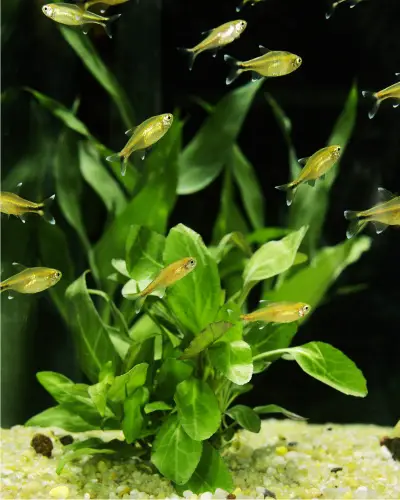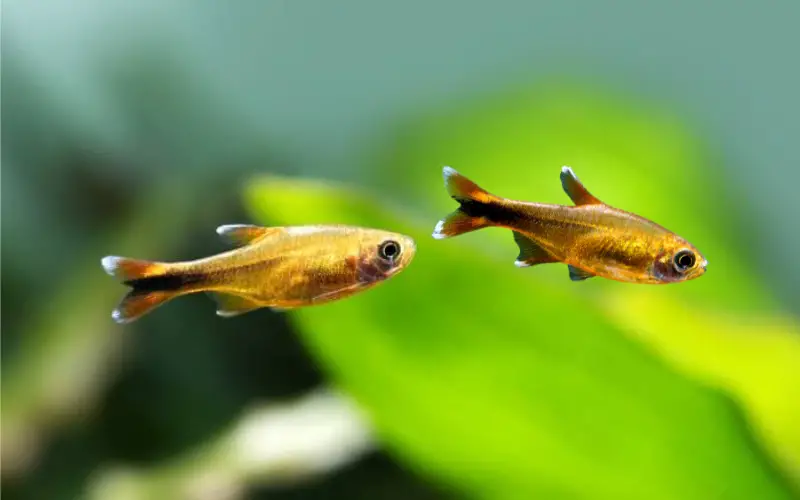Are you looking for a vibrant and easy-to-care-for fish to add to your aquarium? Silver Tip Tetra fish is not just another addition to your aquarium; they represent a lively and engaging choice for both novice and experienced aquarists.
This ultimate Guide is here to help you understand everything about this lively species. Whether you’re a novice or an experienced aquarist, this guide covers all you need to know!
Silver Tip Tetras are one of the energetic schooling fish known for their shimmering silver bodies and golden-tipped fins.
These fun and interactive schooling fish thrive in well-maintained tanks, are peaceful yet active, and require a high quality diet for optimal health.
In this guide, we’ll cover tank requirements, feeding habits, breeding tips, and expert care recommendations from renowned aquarists.

But caring for SilverTip Tetras goes beyond just setting up a tank. Understanding their behavior, ideal tank mates, and health considerations will ensure they flourish in your aquarium.
So, let’s dive in and explore everything about these fascinating fish!
Table of Contents
ToggleWhat are Silver Tip Tetras?
Silver Tip Tetras, scientifically known as Hasemania nana, are small, active fish that are often favored for their vibrant appearance and schooling behavior. They are characterized by their transparent bodies adorned with a distinctive black stripe that runs along their sides, giving them a beautiful aesthetic in a planted tank.
Silver Tipped Tetras are social creatures, thriving in shoals, and they are one of our favorite schooling fish for community fish tank. Their playful nature makes them a joy to observe, darting around the tank in a coordinated manner, reminiscent of a choreographed dance.

These fish typically reach a size of about 1.5 inches, making them suitable for Nano aquariums. They are peaceful and can coexist with various species, including betta fish and dwarf cichlids.
However, they should be kept in groups of at least six to ensure they feel secure and exhibit their natural behaviors. With their long fins and lively disposition, Silver Tipped Tetras are not only a pleasure to keep but also serve as an integral part of a balanced aquatic community.
What Do Silver Tip Tetras Eat?
Feeding Silver Tip Tetras is relatively straightforward, as they are not particularly picky eaters. In their natural habitat, they consume a diet rich in small insects, zooplankton, and algae, which can be mimicked in captivity with high-quality flake food.
A varied high quality diet is essential to maintain their health and vibrancy. In addition to flake food, many Silver Tip tetra hasemania nana thrive on live foods such as baby brine shrimp and daphnia, which provide essential nutrients and stimulate their natural hunting instincts.
It’s crucial to ensure that any food is appropriately sized for these small fish, as oversized food can lead to health issues or stress. Additionally, incorporating some high-quality frozen foods can enhance their diet and promote overall growth and color.
Regular feeding of both dry and live foods keeps them active and healthy, contributing to their lively nature. Always remember to observe their feeding habits to adjust portions accordingly and prevent overfeeding, which can lead to water quality issues in the aquarium.
How to Breed Silver Tip Tetras?
Breeding Silver Tip Tetras can be a rewarding experience, but it requires careful planning and attention to detail. These fish are not easily sexed, making it challenging for beginners to identify males from females. However, males tend to be slightly smaller and have more vibrant colors.
To initiate breeding, it’s advisable to keep a group of juveniles in a well-maintained aquarium that mimics their natural environment with plenty of plants and soft, acidic water, ideally around a pH of 6.0 to 6.8.
Once conditions are optimal, the males will display courtship behaviors, which may include chasing and displaying their fins to attract females. Spawning usually occurs in the early morning hours, and females may lay hundreds of eggs among the plants.
After spawning, it’s essential to remove the parents to prevent them from eating the eggs. The eggs will hatch in about 24 to 36 hours, and the fry can be fed with infusoria or finely crushed flake food until they grow large enough to consume larger foods. Breeding can thus be a fun and interactive experience, enhancing your aquarium’s diversity.
How to Set Up an Aquarium for Silvertip Tetras
Setting up an aquarium for SilverTip Tetras requires attention to several key factors to ensure a thriving environment. Firstly, it’s crucial to select a tank that holds at least 20 gallons, as these active fish enjoy swimming space.
A lushly planted tank is ideal, providing ample hiding spots and open swimming areas. Incorporating live plants, such as Java Moss or Anubias, can mimic their natural habitat and help maintain water quality by absorbing excess nutrients.
Water conditions play a vital role in their well-being, so aim for slightly acidic water with a pH between 6.0 and 8.0. Regular water changes and filtration are necessary to maintain a healthy environment. Additionally, consider adding suitable tank mates like danios and gourami, as they complement the peaceful nature of Silver Tipped Tetras.
Lastly, ensure the tank is covered, as these fish are known to jump. An ideal setup fosters a vibrant and interactive community where Silver Tip Tetra hasemania nana can thrive and showcase their playful behaviors.
Commonly Asked Questions about the SilverTip Tetra (FAQs)
What are the ideal tank conditions for Silver Tip Tetra?
Silver Tip tetra hasemania nana easily tolerate temperatures between 74-82°F. It’s recommended to keep them in a well-planted tank with plenty of swimming space to accommodate their high activity level.
Can Silver Tip Tetras live with dwarf shrimp?
Yes, Silver Tipped Tetra can coexist with dwarf shrimp in a community tank. However, ensure that the shrimp have plenty of hiding spots to escape the tetras’ playful nature.
What should I feed my SilverTip Tetras?
Silver Tip Tetras thrive on a varied diet. You can feed them high-quality pellets, freeze-dried foods, and live baby brine shrimp. A balanced mealtime will keep them healthy and active.
How many Silver Tip Tetras should I keep together?
It’s always recommended to keep Silver Tip Tetras in a big enough group of at least six or more. This not only mimics their natural schooling behavior but also keeps them lively and social.
Are Silver Tip Tetras compatible with long-finned fish?
While Silver Tip Tetras are generally community fish, they might exhibit fin-nipping behavior towards long-finned fish. It’s best to monitor their interactions in a mixed tank.
How do you distinguish between male and female Silver Tip Tetras?
Silver Tipped Tetras cannot easily be sexed as adults. However, adult males may deepen in color and display more vibrant fins compared to females.
What makes SilverTip Tetra fish stand out among other tetras?
The common name of Silver Tip Tetras comes from their unique coloration and fin tips. Their transparent bodies and high activity level set them apart from many comparable smaller tetras.
What are the best tank mates for Silver Tip Tetras?
Silver Tip Tetras do well with other active community fish that have similar water requirements. Suitable tank mates include other tetras, small rasboras, and bottom dwellers.
How do Silver Tipped fish behave during feeding time?
During mealtime, silver tipped tetras exhibit a feeding frenzy reminiscent of their natural behavior. They will actively chase after food, so it’s a fun experience to watch them follow your finger at the tank surface.
Conclusion
In conclusion, Silver Tip Tetras are a fantastic choice for both beginners and experienced aquarists alike. Their beautiful appearance, active behavior, and peaceful nature make them one of the favorite schooling fish for community aquariums. By providing them with a well-maintained and lushly planted environment, along with a varied diet, you can ensure their health and happiness. Whether you are looking to enrich your existing aquarium or start a new aquatic adventure, the Silver Tip Tetra is an amazing Nano fish that will bring joy and excitement to your aquatic experience.
Recent blog posts
- Top 5 Compatible Pristella Tetra Tank Mates (Ultimate Guide)
- X Ray Tetras Fish 101: A Guide to Pristella Maxillaris Care
- Silver Tip Tetra Size 101: Tips for Monitoring Their Growth!
- Max Diamond Tetra Size 101: Care Guide for Moenkhausia Pittieri
- Temperature for Diamond Tetras 101: (Tips for a Stable Aquarium)
- SilverTip Tetra Breeding 101: Beginners Comprehensive Guide
- Silvertip Tetra Fish Lifespan in Aquarium (Ultimate Care Guide)
- Silver Tip Tetra Chasing Each Other: Is it Mating or Fight?
- Choosing the Best Silver tip Tetra Tank Mates: (Dos and Don’ts)
- The Ideal Silver Tip Tetra Fish Temperature: Comprehensive Guide
- Are Silvertip Tetra Aggressive Fish Species: (Expert Advice)
- Mixing Silver Tip Tetra and Guppies Fish: (Dos and Don’ts)




